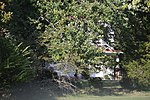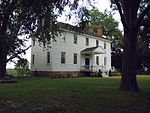Arlington-Five Forks-Kenwood, Virginia
Central Virginia geography stubsFormer census-designated places in VirginiaUnincorporated communities in Prince George County, VirginiaUnincorporated communities in VirginiaUse mdy dates from July 2023
Arlington-Five Forks-Kenwood was a census-designated place (then termed an unincorporated place) in Prince George County, Virginia, United States. Its first and only designation was at the 1950 United States Census when it had a population of 4,124. Arlington-Five Forks-Kenwood did not reappear at subsequent censuses.
Excerpt from the Wikipedia article Arlington-Five Forks-Kenwood, Virginia (License: CC BY-SA 3.0, Authors).Arlington-Five Forks-Kenwood, Virginia
Virginia Street, Hopewell
Geographical coordinates (GPS) Address Nearby Places Show on map
Geographical coordinates (GPS)
| Latitude | Longitude |
|---|---|
| N 37.279880555556 ° | E -77.305347222222 ° |
Address
Virginia Street 3010
23860 Hopewell
Virginia, United States
Open on Google Maps







